第七讲 句法特定结构及其他语法现象_主谓一致
- 格式:wps
- 大小:48.50 KB
- 文档页数:6
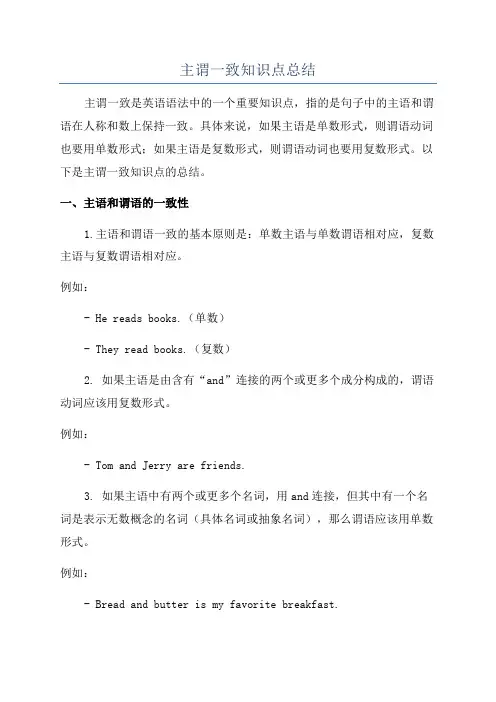
主谓一致知识点总结主谓一致是英语语法中的一个重要知识点,指的是句子中的主语和谓语在人称和数上保持一致。
具体来说,如果主语是单数形式,则谓语动词也要用单数形式;如果主语是复数形式,则谓语动词也要用复数形式。
以下是主谓一致知识点的总结。
一、主语和谓语的一致性1.主语和谓语一致的基本原则是:单数主语与单数谓语相对应,复数主语与复数谓语相对应。
例如:- He reads books.(单数)- They read books.(复数)2. 如果主语是由含有“and”连接的两个或更多个成分构成的,谓语动词应该用复数形式。
例如:- Tom and Jerry are friends.3. 如果主语中有两个或更多个名词,用and连接,但其中有一个名词是表示无数概念的名词(具体名词或抽象名词),那么谓语应该用单数形式。
例如:- Bread and butter is my favorite breakfast.4. 如果主语是由连词“either…or”或“neither…nor”连接的两个名词构成的,谓语动词的单复数应与紧挨着的名词一致。
例如:5. 如果主语是由连词“not only…but also”连接的两个名词构成的,谓语动词的单复数应与紧挨着的名词一致。
例如:- Not only the teacher but also the students are going to the park.二、主谓一致的特殊情况1. 主语是以“everyone, everybody, someone, somebody, no one, nobody, anyone, anybody, each”等单词开头的不定代词时,谓语动词应该用单数形式。
例如:- Everyone knows the answer.2. 对于由and连接的两个主语,如果它们指的是同一个人或同一个物,谓语动词应该用单数形式。
例如:- Tom and Jerry is a famous cartoon.3. 对于固定短语“a number of + 名词”,谓语动词应该用复数形式。
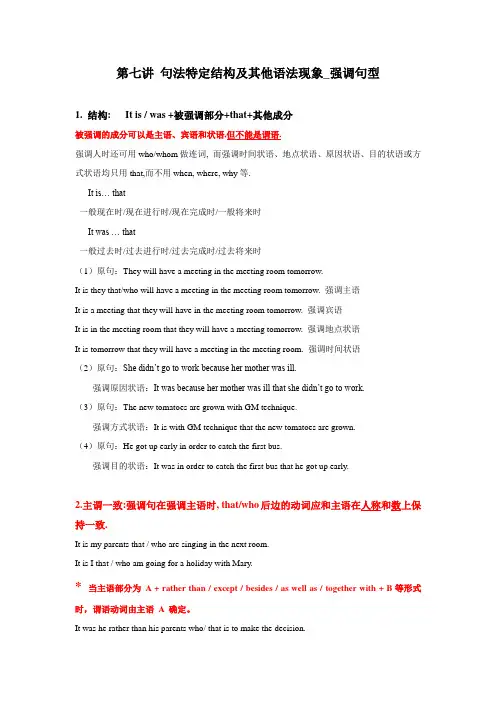
第七讲句法特定结构及其他语法现象_强调句型1. 结构: It is / was +被强调部分+that+其他成分被强调的成分可以是主语、宾语和状语,但不能是谓语.强调人时还可用who/whom做连词, 而强调时间状语、地点状语、原因状语、目的状语或方式状语均只用that,而不用when, where, why等.It is… that ----一般现在时/现在进行时/现在完成时/一般将来时It was … that----一般过去时/过去进行时/过去完成时/过去将来时(1)原句:They will have a meeting in the meeting room tomorrow.It is they that/who will have a meeting in the meeting room tomorrow. 强调主语It is a meeting that they will have in the meeting room tomorrow. 强调宾语It is in the meeting room that they will have a meeting tomorrow. 强调地点状语It is tomorrow that they will have a meeting in the meeting room. 强调时间状语(2)原句:She didn’t go to work because her mother was ill.强调原因状语:It was because her mother was ill that she didn’t go to work.(3)原句:The new tomatoes are grown with GM technique.强调方式状语:It is with GM technique that the new tomatoes are grown.(4)原句:He got up early in order to catch the first bus.强调目的状语:It was in order to catch the first bus that he got up early.2.主谓一致:强调句在强调主语时, that/who后边的动词应和主语在人称和数上保持一致.It is my parents that / who are singing in the next room.It is I that / who am going for a holiday with Mary.* 当主语部分为A + rather than / except / besides / as well as / together with + B等形式时,谓语动词由主语A 确定。
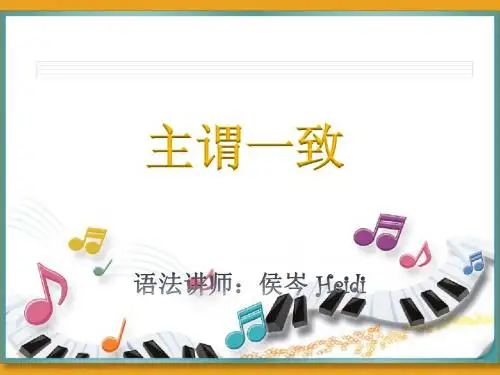
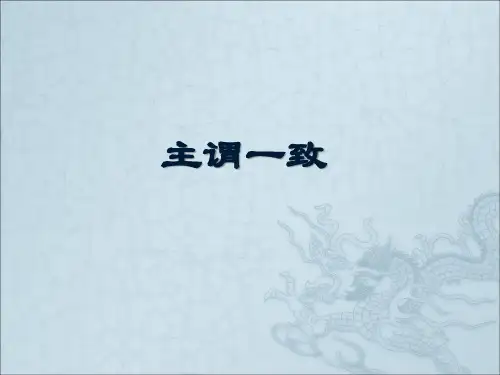
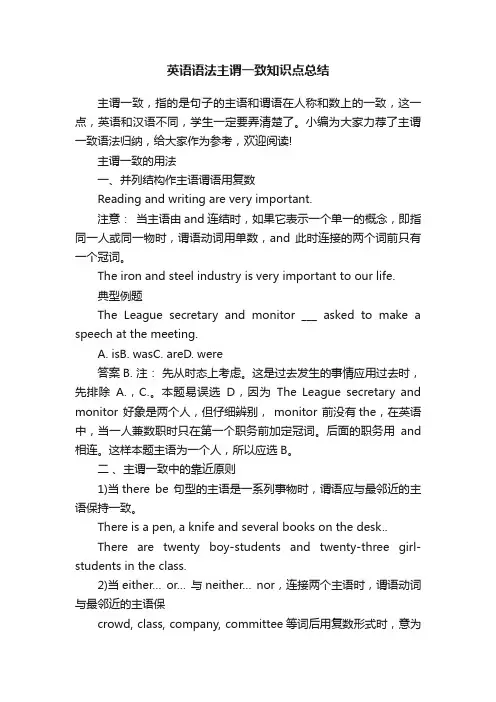
英语语法主谓一致知识点总结主谓一致,指的是句子的主语和谓语在人称和数上的一致,这一点,英语和汉语不同,学生一定要弄清楚了。
小编为大家力荐了主谓一致语法归纳,给大家作为参考,欢迎阅读!主谓一致的用法一、并列结构作主语谓语用复数Reading and writing are very important.注意:当主语由and连结时,如果它表示一个单一的概念,即指同一人或同一物时,谓语动词用单数,and 此时连接的两个词前只有一个冠词。
The iron and steel industry is very important to our life.典型例题The League secretary and monitor ___ asked to make a speech at the meeting.A. isB. wasC. areD. were答案B. 注:先从时态上考虑。
这是过去发生的事情应用过去时,先排除A.,C.。
本题易误选D,因为The League secretary and monitor 好象是两个人,但仔细辨别,monitor 前没有the,在英语中,当一人兼数职时只在第一个职务前加定冠词。
后面的职务用and 相连。
这样本题主语为一个人,所以应选B。
二、主谓一致中的靠近原则1)当there be 句型的主语是一系列事物时,谓语应与最邻近的主语保持一致。
There is a pen, a knife and several books on the desk..There are twenty boy-students and twenty-three girl-students in the class.2)当either… or… 与neither… nor,连接两个主语时,谓语动词与最邻近的主语保crowd, class, company, committee等词后用复数形式时,意为这个集体中的各个成员,用单数时表示该个集体。
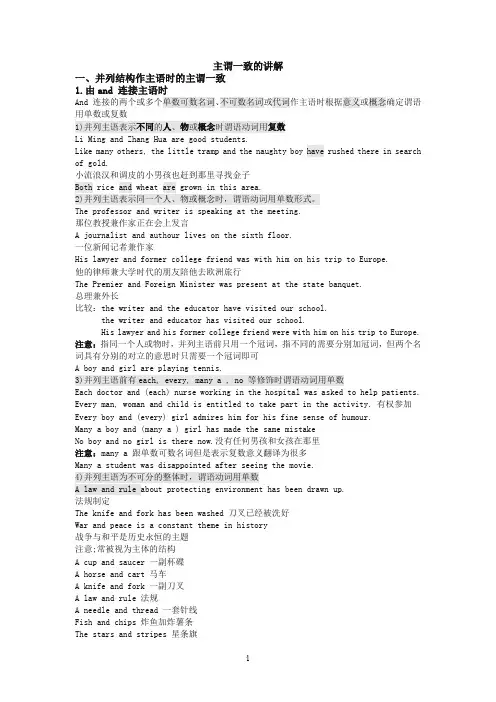
主谓一致的讲解一、并列结构作主语时的主谓一致1.由and 连接主语时And 连接的两个或多个单数可数名词、不可数名词或代词作主语时根据意义或概念确定谓语用单数或复数1)并列主语表示不同的人、物或概念时谓语动词用复数Li Ming and Zhang Hua are good students.Like many others, the little tramp and the naughty boy have rushed there in search of gold.小流浪汉和调皮的小男孩也赶到那里寻找金子Both rice and wheat are grown in this area.2)并列主语表示同一个人、物或概念时,谓语动词用单数形式。
The professor and writer is speaking at the meeting.那位教授兼作家正在会上发言A journalist and authour lives on the sixth floor.一位新闻记者兼作家His lawyer and former college friend was with him on his trip to Europe.他的律师兼大学时代的朋友陪他去欧洲旅行The Premier and Foreign Minister was present at the state banquet.总理兼外长比较:the writer and the educator have visited our school.the writer and educator has visited our school.His lawyer and his former college friend were with him on his trip to Europe. 注意:指同一个人或物时,并列主语前只用一个冠词,指不同的需要分别加冠词,但两个名词具有分别的对立的意思时只需要一个冠词即可A boy and girl are playing tennis.3)并列主语前有each, every, many a , no 等修饰时谓语动词用单数Each doctor and (each) nurse working in the hospital was asked to help patients. Every man, woman and child is entitled to take part in the activity. 有权参加Every boy and (every) girl admires him for his fine sense of humour.Many a boy and (many a ) girl has made the same mistakeNo boy and no girl is there now.没有任何男孩和女孩在那里注意:many a 跟单数可数名词但是表示复数意义翻译为很多Many a student was disappointed after seeing the movie.4)并列主语为不可分的整体时,谓语动词用单数A law and rule about protecting environment has been drawn up.法规制定The knife and fork has been washed 刀叉已经被洗好War and peace is a constant theme in history战争与和平是历史永恒的主题注意;常被视为主体的结构A cup and saucer 一副杯碟A horse and cart 马车A knife and fork 一副刀叉A law and rule 法规A needle and thread 一套针线Fish and chips 炸鱼加炸薯条The stars and stripes 星条旗2.由(either)…or 或neither…nor 等连接的主语时由 either…or, neither…nor, or, not only…but(also)…连接主语时,谓语动词陈述句中就近原则Either you or Jane is to be sent to New York.要么你要么简被派往纽约Neither you nor he has finished the experiment.Neither the teacher nor the students like this piece of music. 都不喜欢这首曲子Not only the old farmer but also his family were friendly to me.Not only his friends but also he himself is looking forward to taking part in the party.3.主语由肯定否定两部分构成谓语跟肯定部分走Not you but I am to answer the questionI, not you, am to answer the question.二、单一主语的主谓一致1.名词本身自带s作主语时1)学科名词: physics 物理 mathematics/maths 数学 economics 经济学 politics政治学新闻; news体操:GymnasticsAs we know, Physics is a fundamental subject in science.物理是自然科学中的一门基础学科Mathematics is a required course for middle school students.数学是中学生的一门必修课Einstein once said ,“Politics is much more difficult than physics.”注意:当mathematics 表示运算时谓语动词用单数复数都可If my mathematics is/are right, the answer is 56.如果我的运算正确,答案就是56 The television news is at 7 o’clock in the evening every dayGymnastics is my sister’s favourite sport2)有些名词单复数同行根据是单数概念还是复数概念判断谓语 means方式方法 aircraft 飞机works 工厂 crossroads十字路口 deer 鹿 sheep 羊 fish 鱼This works was build in 1982 这座工厂是By far, three steelworks have been closed down in this cityThis means of transport has been triedAll possible means have been tried3)由两部分组成的物体名词作主语时,谓语动词用复数chopsticks筷子 compasses 圆规glasses眼镜 gloves手套Jeans牛仔裤 pants裤子scissors剪子 shoes鞋子shorts短裤 socks短袜trousers裤子My trousers are white and his clothes are black.我的裤子是白色的他的衣服是黑色的Why are your shoes so dirty?注意;如果这些词由单位词(a pair of , a suit of , a piece of , a kind of 等)修饰时,单位词的单复数决定谓语动词的单复数A pair of scissors is lying in that drawer.These kinds of glasses are popular this summer.4)表示国家、人名、书名、组织机构等的专有名词作主语时,谓语动词用单数The united States is a developed countryThe New York Times is widely read in the world.5)以-s 结尾的群岛、山脉、海峡、瀑布等专有名词谓语动词用复数The Himalayas have a magnificent variety of plants.植物种类繁多The Niagara Falls are splendid waterfalls.6)以-S结尾的名词作主语时谓语动词用复数belongings财产 clothes衣服 plasticsearnings收入 goods货物leavings剩余 savings储存All the goods are very expensive.2.集体名词作主语时1)mankind, humanity, man 作主语时,谓语一般用单数Only man knows how to cook. 只有人懂得烹饪【注】mankind 表示“人(类)”有时表示复数意义,尤其是其表语是复数时:Mankind are intelligent animals. 人是理智的动物.2)people, police, cattle, youth等作主语时,只有单数形式, 但却表示复数意义谓语动词用复数The police are investigating the riot. 正在调查暴乱事件The cattle are grazing the the field 正在牧场吃草Many cattle were killed for this. 就因为这个原因宰了不少牲畜【注】people作民族讲时有复数形式.如: There are 56 peoples in China3)family, crowd 等作主语时,根据概念确定谓语动词这类集体名词有:Army, assembly议会集会 audience band class club committee company congress议会youth crew 全体工作人员 crowd enemy family gang团伙government group herd牧群 jury population public team强调整体用单数谓语强调个体用复数谓语The family is going to move to New YorkThe family have different opinions about their going abroadThe football club committee arranges all the matchesThe football club committee have decided to dismiss him.比较:A family , a group , a class 做主语时用单数谓语Families, groups, classes 作主语时用复数谓语A group is coming to the zoo.一队人正朝着动物园走来4)baggage / luggage(行李), clothing(衣服), furniture(家具), machinery(机器), poetry(诗), scenery(风景), jewelry(珠宝), equipment(设备)等,是不可数名词,只用单数形式,不用不定冠词(当然更不能用数词)Our clothing protects us from [against] the cold. 我们的衣服可以御寒.Have you checked all your baggage? 你所有行李都托运了吗?【注】machinery, poetry, jewelry, scenery等相应的个体可数名词是 machine, poem, jewel, scene等.如:a poem / a piece of poetry(一首诗),many machines / much machinery / many pieces of machinery(许多机器).5)hair的用法hair(头发,毛发)指全部头发或毛发时,为集合名词(不可数);指几根头发或毛发时,为个体名词(可数):My hair has grown very long. 我的头发已长得很长了.The police found two hairs there. 警察在那儿找到了两根头发.6)fruit的用法fruit(水果)作为集合名词,它通常是不可数的:He doesn’t eat much fruit. 他不大吃水果.He is growing fruit in the country. 他在乡下种水果.但是,当要表示种类时,它可视为可数名词,即a fruit 指一种水果,fruits 指多种水果.比较:Some fruits have thick skins. 有些水果皮很厚.3.非谓语动词或从句作主语时1)非谓语动词或从句作主语时谓语动词用单数To improve agricultural land needs a lot of money.改善耕地质量需要投入大量的资金To see is to believeSwimming is a good way to keep healthHow they will solve the problem remains to be seenWhether she will come is not known2)多个非谓语动词作主语,表达一个概念谓语用单数,表达不同概念谓语用复数Going to be early and getting up early is good for your health.早睡早起一个概念Reading books and playing table tennis are my great pleasure.读书和打乒乓球Listening, speaking, reading and writing are all important.To be strict with oneself and to be kind to others are good qualities of a person三、其他情况的主谓一致1.表示距离、时间、长度、金额、质量等的复数名词作主语时常被看作是整体谓语动词用单数这类复数名词有:miles, dollars, pounds, kilograms公斤千克, kilometres公里, centimetres,厘米 millimetres毫米, seconds, hours, years等Five dollars seems a fair price 是一个公道的价格Two kilometres is not very far for the young manFive hours is a short time for such a difficult job2.如果强调数目谓语动词用复数One hundred cents make a dollarMore than twenty years have passed since they got married.3.算数中的谓语动词一般用单数形式,有时也用复数Five times eight is/are fortyFour and eight makes/make twelveSixty minus seven leaves fifty-threeForty-eight divided by six is eight4.复合不定代词作主语时谓语动词用单数Everyone something anybody nowhereEveryone in the class was surprised at the newsListen! Someone is knocking at the door.Is anyone going to tell him the news?5.each one of…, every one of …, anyone of…, one of…, 等作主语时谓语用单数Each of the girl in our class has a balloon 我们班每个女孩都有一个气球Each of the students was asked to speak for three minutes.Every one of them is familiar to me. 我对他们都很熟悉6.each , every 作形容词修饰主语时谓语动词用单数但是each 作复数主语的同位语时谓语用复数Each/Every boy in our class has a skateboard一副滑板They each have a stateboardEach/Every student has an English-Chinese dictionaryThe students each have an English-Chinese dictionary7.none of + 不可数名词谓语用单数none of,neither of, + 可数名词复数/复数代词 + 谓语动词单数复数都可either of ,None of that money in the desk is his 不可数名词None of his classmates knows the truth.= None of his classmates know the truth Neither of the statements is true = Neither of the statements are true 两种说法没有一个真实Either of the qualifications is acceptable = Either of the qualifications are acceptable8.neither 与 either 做形容词修饰单数名词时谓语动词用单数Either qualification is acceptable两种资格中的任何一种都可以接受Neither qualification is acceptable9.分数百分数+ of + 名词,some of , plenty of, a lot of, lots of, most of, the rest of, all(of), half(of) 谓语常与of 后面的名词一致分数/百分数 + of + 复数名词/ 复数代词谓语动词用复数分数/百分数 + of + 单数名词/单数代词谓语动词用单数不可数名词Two thirds of the students support the plan复数名词One tenth of them are suffering from this kind of illness.复数代词Three fourths of the surface of the earth is sea单数名词Eighty percent of the employees in the company are from Beijing百分数复数名词Thirty percent of its area is flooded each year.百分数单数名词The rest of the money belongs to youThe rest of the students speak for it.Half of the apple is rottenHalf of the apples are rotten10.more(…) than one…结构作主语时More(…)than one…+ 单数名词谓语用单数More + 复数名词 + than one 谓语用复数More than two + 复数名词谓语用复数More than one white rose has bloomed in the gardenMore white roses than one have bloomed in the gardenMore than two white roses have bloomed 两个以上的的白玫瑰开了11.a number of + 复数名词谓语用复数许多的The number of + 名词谓语动词用单数…的数量A number of trees are green in AprilA great number of tourists have been to the Great WallA large number of worker were out of work because the factory was destroyed in flood.The number of students in the computer class is limited to ten.The number of workers who were out of work was 1,000.12.there/here…引导句子时就近原则There are some chairs and a table in the roomThere is a table and some chairs in the roomHere are some gifts for youHere is a book, a pen and some paper for you.13.当主语后接修饰语时With, along with, together with, but, besides, except, like, including, in addition to, as well as, rather than, 谓语动词与前面的主语保持一致A library with five thousand books is offered to the nation as a gift被作为礼物送给了这个国家The teacher, along with her students, is going to attend the lecture 听报告A peasant, together with some soldiers, is about to help us.All but one have arrived here.除了一个人外所有人都到了No one except two students was late for class.再没有其他人上课迟到The garage, in addition to the house, was burned.She as well as the other girls is going to another supermarked.You as well as I are wrong.The father, rather than the brother, is responsible.父亲而不是兄弟们应当负责14.The+ 形容词做主语时表示一类人用复数谓语表示抽象概念用单数谓语The injured were carried away on stretchers.用担架抬走了The old are more likely to catch cold than the youngThe rich are for the decision but the poor are against it.The young are always full of vitality充满了活力The unknown is always something to be feared 未知的东西总是令人害怕The beautiful is not always the good, and the good is not always the true.美未必是善善未必是真The true is to be distinguished from the false真应与假相区别The good is what people like 人们总是喜欢美好的东西In many stories, the good are well rewarded and the bad are punished.好人有好报坏人有怀抱15.all做主语时指一切表示单数概念用单数谓语,指具体人或物用复数谓语All has been tried一切都试过了All were silent 大家都一言不发All was silent 万籁俱寂All are here now 大家都在16.由 a kind of, this kind of, many kinds of, 名词+of this kind, a type of asort of 谓语动词根据of 后面的名词来定A new type of machine is on show now. Machines of this kind are made in Wuhan欢迎您的下载,资料仅供参考!致力为企业和个人提供合同协议,策划案计划书,学习资料等等打造全网一站式需求。
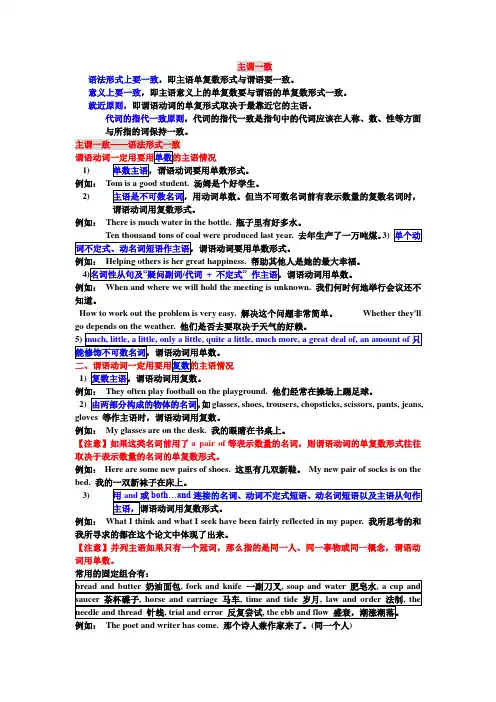
主谓一致语法形式上要一致,即主语单复数形式与谓语要一致。
意义上要一致,即主语意义上的单复数要与谓语的单复数形式一致。
就近原则,即谓语动词的单复形式取决于最靠近它的主语。
代词的指代一致原则,代词的指代一致是指句中的代词应该在人称、数、性等方面与所指的词保持一致。
例如:Tom is a good student. 汤姆是个好学生。
2)谓语动词用复数形式。
例如:There is much water in the bottle. 瓶子里有好多水。
去年生产了一万吨煤。
例如:Helping others is her great happiness. 帮助其他人是她的最大幸福。
例如:When and where we will hold the meeting is unknown. 我们何时何地举行会议还不知道。
How to work out the problem is very easy. 解决这个问题非常简单。
Whether they'll例如:They often play football on the playground. 他们经常在操场上踢足球。
2) 如glasses, shoes, trousers, chopsticks, scissors, pants, jeans, gloves 等作主语时,谓语动词用复数。
例如:My glasses are on the desk. 我的眼睛在书桌上。
【注意】如果这类名词前用了a pair of等表示数量的名词,则谓语动词的单复数形式往往取决于表示数量的名词的单复数形式。
例如:Here are some new pairs of shoes. 这里有几双新鞋。
My new pair of socks is on the bed.3)例如:What I think and what I seek have been fairly reflected in my paper. 我所思考的和我所寻求的都在这个论文中体现了出来。
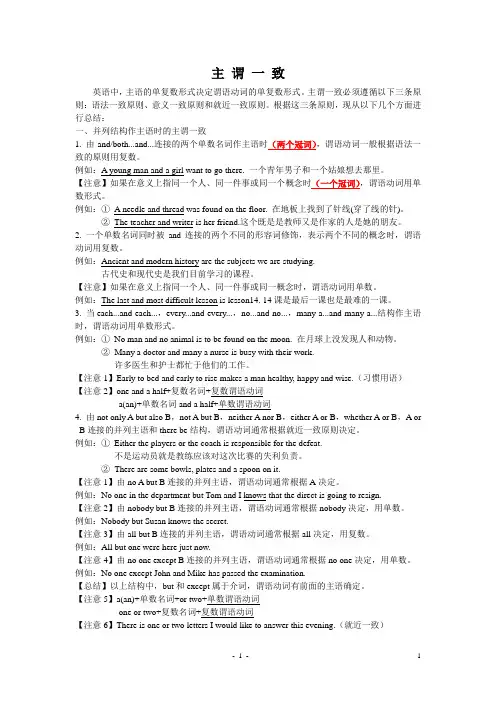
主谓一致英语中,主语的单复数形式决定谓语动词的单复数形式。
主谓一致必须遵循以下三条原则:语法一致原则、意义一致原则和就近一致原则。
根据这三条原则,现从以下几个方面进行总结:一、并列结构作主语时的主谓一致1. 由and/both...and...连接的两个单数名词作主语时(两个冠词),谓语动词一般根据语法一致的原则用复数。
例如:A young man and a girl want to go there. 一个青年男子和一个姑娘想去那里。
【注意】如果在意义上指同一个人、同一件事或同一个概念时(一个冠词),谓语动词用单数形式。
例如:①A needle and thread was found on the floor. 在地板上找到了针线(穿了线的针)。
②The teacher and writer is her friend.这个既是是教师又是作家的人是她的朋友。
2. 一个单数名词同时被and连接的两个不同的形容词修饰,表示两个不同的概念时,谓语动词用复数。
例如:Ancient and modern history are the subjects we are studying.古代史和现代史是我们目前学习的课程。
【注意】如果在意义上指同一个人、同一件事或同一概念时,谓语动词用单数。
例如:The last and most difficult lesson is lesson14. 14课是最后一课也是最难的一课。
3. 当each...and each...,every...and every...,no...and no...,many a...and many a...结构作主语时,谓语动词用单数形式。
例如:①No man and no animal is to be found on the moon. 在月球上没发现人和动物。
②Many a doctor and many a nurse is busy with their work.许多医生和护士都忙于他们的工作。
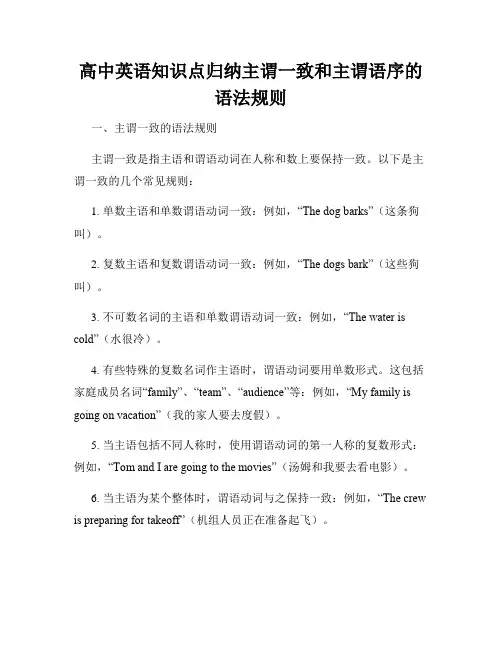
高中英语知识点归纳主谓一致和主谓语序的语法规则一、主谓一致的语法规则主谓一致是指主语和谓语动词在人称和数上要保持一致。
以下是主谓一致的几个常见规则:1. 单数主语和单数谓语动词一致:例如,“The dog barks”(这条狗叫)。
2. 复数主语和复数谓语动词一致:例如,“The dogs bark”(这些狗叫)。
3. 不可数名词的主语和单数谓语动词一致:例如,“The water is cold”(水很冷)。
4. 有些特殊的复数名词作主语时,谓语动词要用单数形式。
这包括家庭成员名词“family”、“team”、“audience”等:例如,“My family is going on vacation”(我的家人要去度假)。
5. 当主语包括不同人称时,使用谓语动词的第一人称的复数形式:例如,“Tom and I are going to the movies”(汤姆和我要去看电影)。
6. 当主语为某个整体时,谓语动词与之保持一致:例如,“The crew is preparing for takeoff”(机组人员正在准备起飞)。
7. 当主语中包括“each”、“every”、“either”、“neither”、“everyone”、“nobody”等词时,谓语动词用单数形式:例如,“Every student has to submit their homework”(每个学生都必须提交他们的作业)。
二、主谓语序的语法规则主谓语序指的是主语和谓语动词的顺序要保持一致。
以下是主谓语序的几个常见规则:1. 在陈述句中,主语通常位于谓语动词之前:例如,“She is a teacher”(她是一名老师)。
2. 在疑问句中,将谓语动词放在主语之前:例如,“Are you hungry?”(你饿了吗?)。
3. 在祈使句中,主语通常省略,谓语动词单独出现:例如,“Sit down”(坐下)。
4. 在条件句中,主语通常位于谓语动词之前:例如,“If it rains, we will stay indoors”(如果下雨,我们就呆在室内)。

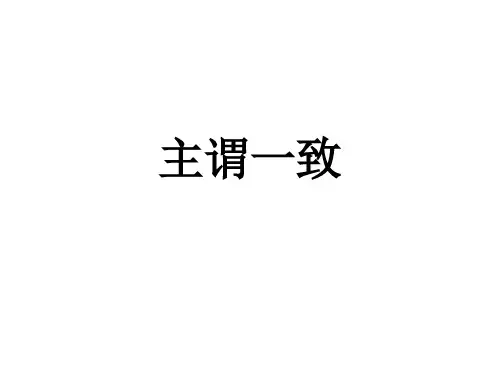
主谓一致主谓一致Subject-Verb Concord即谓语动词在人称和数上要和主语保持一致;主谓一致包括语法一致、意义一致和就近一致;语法一致即谓语动词在单复数形式上要和主语保持一致;意义一致就是谓语动词要和主语意义上的单复数保持一致;就近一致就是谓语动词要和靠近它的主语部分保持一致..表里不一主谓一致中的"表里不一"现象1;"more than one +名词"作主语时;谓语动词常用单数.例如:More than one teacher gets the flowers. 不止一个教师得到了花. 2;"many a +名词"作主语时;从意义上看是复数;但谓语动词常用单数.例如:Many a student has been sent to plant trees. 很多学生被派去植树.3;"half of ;the rest of ;most of ;all of及百分数或分数+of 等后接名词"作主语时;谓语动词形式根据of后的名词而定.例如:Three fourths of the surface of the earth is covered with water.地球表面四分之三为水所覆盖.4;all指人时;动词用复数;all指物时;动词用单数.例如:"All are present and all is going well." 所有人全部到场了;一切进展顺利5;what引导的主语从句;谓语动词可视表语而定:表语是单数名词时;动词用单数;相反;则用复数.例如:What they want to get are a number of good books.他们想得到的是大量的好书.6;and连接的两个单数名词前若用each ;every ;no修饰;该名词短语作主语时;谓语动词用单数形式.例如:No book and no pen is found in the schoolbag.书包里没有书和钢笔.7;当主语后面有as well as ;with ;along with ;together with ;but ;like ;rather than ;except;逗号加and连接几个名词等引导的短语时;谓语动词要与最前面的主语保持一致.例如:My father as well as his workmates has been to Beijing. 我父亲和他的同事曾去过北京.8;each作主语的同位语时;谓语动词由主语来决定;与each无关.例如:They each have a bike. 他们每人有一辆自行车.9;动词不定式;动词-ing形式短语作主语时;谓语动词常用单数.例如:Going out for a walk after supper is a good habit.晚饭后出去散步是一个好习惯.10;the following作主语时;谓语动词的数与后面名词的数保持一致.例如:The following are good examples下面是一些好例子.11;以-ics结尾的学科名词;如politics ;physics ;mathematics等作主语时;谓语动词用单数.以-s结尾的名词news ;works ;plastics等同属此类.例如:Politics is now taught in all schools. 现在各学校都开设政治课.当以-ics结尾的学科名词表示"学科"以外的意义时;用作复数;如:mathematics运算能力politics政治观点economics经济意义等..12;有些用来表示由两个对应部分组成一体的名词复数trousers ;glasses ;shoes .shorts .scissors .scales等作主语时;前面若有"一条";"一副";"一把"之类的单位词;动词用单数;若没有单位词或单位词是复数;则谓语动词用复数.例如:The shoes are all right. 这些鞋子都很合适.还有一些以-s结尾的名词通常用复数:arms武器.clothes .contents .minutes记录.remains遗体.thanks等13;"one and a half +名词"作主语时;谓语动词要用单数.例如:One and a half apples is left on the table. 桌子上有一个半苹果.14;"One or two more +复数名词"作主语时;谓语动词用复数.例如:One or two persons are sent there to help them do the work. 要派一两个人到那儿去给他们帮忙.15;"one of+复数名词+ 定语从句"结构中;定语从句的谓语动词要用复数;而在"the only one of +复数名词+定语从句"的结构中;"the one of + 复数名词+定语从句"定语从句的谓语动词要用单数.例如:He is one of the students who get there on time.他是准时到达那里的学生之一.16;表示时间;距离;金钱等的复数名词作主语表达一个整体概念时;谓语动词常用单数;但若强调数量;谓语动词可用复数.例如:One million dollars is a lot of money. 一百万美元是一大笔钱. -s结尾一以-s结尾的疾病名称作主语的主谓一致问题;以-s结尾的疾病名称作主语的主谓一致问题;如:arthritis ;bronchitis ;diabetes ;mumps ;phlebitis ;rickets;这类以-s结尾的疾病名称作主语时;谓语动词通常用作单数..例如:Arthritis causes great pain in the joints of the patient.二以-s结尾的游戏名称作主语的主谓一致问题;以-s结尾的游戏名称作主语时;谓语动词通常用作单数..例如:Darts is basically an easy game.但当Darts;Marbles等的意义为游戏器具而非游戏名称时;谓语动词通常用作复数..例如:Three darts are thrown at each turn.All nine skittles were brought down by the good throw.三以-s结尾的地理名称作主语的主谓一致问题;某些以-s结尾的地理名称;如果是国名;如the United States;the Netherlands等;因其是单一政治实体;所以谓语动词用作单数..例如:The United States was hit by the Great Depression in 1930s'.In early January 1996 the Netherlands was hit by its worst storm since 1976.但如果是群岛、山脉、海峡、瀑布等地理名称作主语;谓语动词用作复数..例如:The West Indies are commonly divided into two parts.四以-ics结尾的学科名称作主语的主谓一致问题;某些以-ics结尾的学科名称作主语时;如physics ;mathematics ;mechanics ;optics ;acoustics ;politics;st atistics ;economics ;linguistics ;athletics等;谓语动词通常用作单数..例如:The third world economics is promising.Athletics is a required course for students of all grades.但如果这类名词表示学科以外的其它含义;可作复数用..例如:Athletics have been greatly encouraged at this college.五其它以-s结尾的名词的主谓一致问题;.以-s结尾的由两部分组成的物体名称作主语;英语中有一些通常以-s结尾的由两部分组成的物体名词;如glasses ;pincers ;pliers ;scissors ;shorts ;suspenders ;trousers 等; 为复数名词;后接复数谓语集合名词1单数—复数型.凡是有复数词尾变化形式的集合名词都属于此类.如:a class—classes; a family—families; a government—governments; anarmy—armies ;a people—peoples民族; a group—groups; a crowd—crowds; a crew—crews等.这类集合名词强调的是整体性;即当作一个整体或多个整体来看待.属于这类集合名词的单数作主语时;谓语动词用单数;复数形式作主语时;谓语动词用复数.例如A big crowd often gathers on the square every morning.每个上午一大群人经常聚集在广场上The government has decided to pass the bill.政府已决定通过这一法案There are huge crowds in the streets on Sunday.星期天有大群大群的人在街上..There are many English-speaking peoples in the world.在世界上有许多讲英语的民族..但应注意;这类集合名词的单数形式有时表示复数概念;所以这些集合名词的单数形式也可归为"单复同形型"中.2单数型.这类集合名词表示的是人或事物的整体;即把这类人或事物的全部包括在内;所以只有单数形式.如作主语;谓语动词常用单数.这类名词常见的有:humanity ;mankind ;proletariat等.例如The proletariat is the greatest class in the history of mankind. In the fields of production and scientific experiment ;mankind makes constant progress.3复数型.这类集合名词在形式和内容上是相互矛盾的;就是说它们只有单数形式;但表达的都是复数概念.它强调的是集体中的个体性.这类名词有:police ;cattle ;faculty ;flock ;machinery ;vermin ;personnel等.它们作主语时;谓语动词要用复数.例如The police have caught the murder.Our personnel are very highly trained.The vermin are very dangerous.4单复同形型.这类集合名词的单数形式既可表示单数也可表示复数.作主语时;用单数动词或复数动词均可;有时意义区别不大;具体看语境;是强调集体还是个体..例如The school teaching staff are is excellent.The public is are requested not to litter in the park.The teaching profession claims to be badly paid.这类集合名词常见的有:class;family;team;crew;board;herd;committee;party;jury;enemy;au dience等.根据说话人的心理意向若把这个集合名词所代表的人或事物看作一个整体;就认为是单数;用单数动词;若把它所代表的人或事物看作若干个个体的话;就认为其为复数;用复数动词.试比较:The football team is playing well.那个足球队打得非常漂亮. The football team are shavings bath and are then coming back here for tea. 足球队员们正在洗澡;然后来这里吃茶点.The family is a very happy one.那个家庭是一个非常幸福的家庭.That family are very pleased about the news of William's success. 全家人对威廉的成功都感到很高兴.典型例题1 并列结构作主语时谓语用复数Reading and writing are very important.注意:当主语由and连接时;如果它表示一个单一的概念;即指同一人或同一物时;谓语动词用is;and 此时连接的两个词前只有一个冠词;共用一个冠词用单数;表示The iron and steel industry is very important to our life.The League secretary and monitor ___ asked to make a speech at the meeting.A. isB. wasC. areD. were答案 B. 注:先从时态上考虑.这是过去发生的事情应用过去时;先排除A.;C..本题易误选D;因为The League secretary and monitor 好象是两个人;但仔细辨别;monitor 前没有the;在英语中;当一人兼数职时只在第一个职务前加定冠词.后面的职务用and 相连.这样本题主语为一个人;所以应选B.2 主谓一致中的就近原则当there be 句型的主语是一系列事物时;谓语应与最邻近的主语保持一致.There is a pen;a knife and several books on the desk..There are twenty boy-students and twenty-three girl-students in the class.总的来说;在由not only…but also…;not just…but…;or;either…or…;neither…nor…连接主语的句子中及在there be句型中;谓语动词的单复数按就近原则处理;即按与谓语动词最靠近的那个主语来确定谓语动词的单复数形式..如:Not only John but also I am going to Shanghai next week.Either you or she is to go.There is a pen ;a few envelops and some paper for you.3 谓语动词与前面的主语一致当主语后面跟有with ;together with ;like; except ;but ;no less than ;as well as 等词引起的短语时;谓语动词与前面的主语一致.The teacher together with some students is visiting the factory. He as well as I wants to go boating.4 谓语需用单数1 代词each和由every ;some ;no ;any等构成的复合代词作主语;或主语中含有each ;every;谓语需用单数.Each of us has a tape-recorder.There is something wrong with my watch.2 当主语是一本书或一条格言时;谓语动词常用单数.The Arabian Night is a book known to lovers of English.<一千零一夜>是英语爱好者熟悉的一本好书.3 表示金钱;时间.距离.价格或度量衡的复合名词作主语时;通常把这些名词看作一个整体;谓语一般用单数.用复数也可;意思不变.Three weeks was allowed for making the necessary preparations. Ten yuan is enough.5 指代意义决定谓语的单复数1 在代词what ;which ;who ;none ;some ;any ;more ;most ;all等词的单复数由其指代的词的单复数决定.All is right. 一切顺利.All are present. 所有人都到齐了.2 集体名词作主语时;谓语的数要根据主语的意思来决定.如family ;team;group;club ;public ;audience ;crew ;crowd ;class ; company ;committee等词后用复数形式时;意为这个集体中的各个成员;用单数时表示该个集体.His family isn't very large. 他家不是一个大家庭.His family are music lovers. 他的家人都是音乐爱好者.但集合名词people ;police ;cattle ;poultry家禽.militia民兵.vermin 害虫等在任何情况下都用复数形式.Are there any police around3有些名词;如variety ;number ;population ;proportion ;majority 等有时看作单数;有时看作复数.A number of +名词复数+动词的第三人称单数形式.The number of +名词复数+动词非第三人称单数形式.A number of books have lent out.The majority of the students like English.6 与后接名词或代词保持一致1 用half of; part of ;most of ;a portion of 等词引起主语时;动词通常与of后面的名词;代词保持一致.Most of his money is spent on books.Most of the students are taking an active part in sports.2 在一些短语;如 many a 或 more than one 所修饰的词作主语时;谓语动词多用单数形式.但由more than… of 作主语时;动词应与其后的名词或代词保持一致.Many a person has read the novel. 许多人都读过这本书.More than 60 percent of the students are from the city.百分之六十多的学生都来自这个城市.7 the+形容词/国籍形容词..表示一类人/一国人;作主语;谓语动词用复数..8 the+姓氏的复数;表示一家人或两夫妇;作主语时;谓语动词用复数;9四则运算时;谓语动词用单数..10 表示;时间;距离;重量;金额;书名的复数名词作主语时;通常当做整体看待;谓语动词用单数..。
主谓一致有许多原则,概括起来不外乎三种一致原则,即:语法一致;意义一致(语言内容上一致);毗邻一致(谓语动词的单复数形式和紧位于其前的主语一致)。
一,语法一致原则语法一致原则是指句子的主语和谓语在语法形式上一致,即通常情况下,谓语动词的单复数形式依主语的单复数形式而定,主语为单数形式时谓语动词用单数形式,主语为复数形式时谓语动词也用复数形式。
掌握主谓一致考点中的语法一致原则,要注意特殊问题1 主语是不可数名词或抽象概念,谓语常用单数。
例如Seeing is beliving. Water is essential to our life.2. 如果主语部分是“分数或百分数+of+名词/代词”,谓语动词的单复数形式取决于of后的名词或代词的单复数形式。
例如:Two’thirds of the earth’s surface is covered by water. 地球表面的2/3是水域。
// 67 percent of the students are girls in our college(学院). 表示“种类、计量单位”的名词kind, sort, type, form, pair, cup, glass, piece, box, chain, series(单数、复数形式同形)、species(单数、复数形式同形)、ton、meter等与of连用构成主语时,由of之前表示“种类、计量单位”的名词决定谓语动词的形式。
例如:This kind of these apples is sweet. // These kinds of apples are very sweet.3. what, which, who, whose等疑问代词作主语时,根据其所指代的含义来确定谓语动词的形式(若其所指代的含义单数不明确,谓语动词通常用单数形式)。
例如:Which is your room?哪是你的房间?// Which are your rooms?哪几间是你们的房间?// Who is your brother?你兄弟是谁?// Who are League Members?哪些是团员?4主语前、后加修饰语时的主谓一致问题。
第七讲句法特定结构及其他语法现象_主谓一致主谓一致(一)“一致”(concord或agreement )指句子成分之间或词语之间在语法形式上的协调关系。
在英语中主要关系是主语和谓语动词之间数的一致。
但最主要的还是主语和谓语的一致。
主谓一致是主语和谓语动词在“人称”和“数”方面的一致关系,这又叫做“主动一致”即Subject + verb + concord,主语和随后的动词词组(即谓语动词)之间的一致关系有三种不同的指导原则:(1)语法一致原则(Grammatical concord)主语和谓语动词之间的一致关系主要表现在“数”的形式上,即用作主语的名词词组中心词和谓语动词在单复形式上的一致。
如果名词中心词是复数,动词就该用复数形式;如果名词中心词不是复数而是单数名词或不可数名词,动词便用单数形式。
这种一致关系叫做语法一致。
如:Both boys have their own merits.Each boy has his owe book .(2)意义一致原则(Notional concord)主语和谓语的一致关系并非取决于语法上的单复数关系形式,还取决于主语的单复数意义,比如有时主语在语法形式上并非复数,但有复数意义,随后的使用复数。
反之,主语在语法形式上是复数而在意义上可视为单数,随后的动词也用单数。
这种一致关系叫意义一致。
如:The government have asked the country to decide by a vote.Fifty-six dollars was stolen from the cash register.(3)就近原则(Principle of proximity)就近原则就是句子的谓语动词的人称和数往往和最近的词或短语保持一致。
如:Only one out of five were present.No one except his own supporters agree with him.Neither the actors nor the play appeals to any one.主谓一致(二)三种不同的指导原则并非绝对,在实际使用中会受习惯用法和不同语体,语域的制约1)以-s 结尾的名词作主语的主谓一致问题:英语可数名词的规则复数形式是在词尾加-s或-es ,但是有一些以-s结尾的名词并非可数名词。
它们当中有的作单数用,有的作复数用,有的既可以作单数也可以作复数用。
这样就造成实际使用上的困难,因此值得注意。
【1】以-s结尾的疾病名词和游戏名称。
英语中有一些疾病名称是以-s结尾的,如arthritis(关节炎),bronchitis(支气管炎),rickets(软骨病),mumps(腮腺炎),diabetes(糖尿病)等,这类名词通常用作单数用。
如:Mumps is a kind of infectious disease.但也有一些疾病名称即可作单数也可作复数用。
如:Generally measles occurs/occur in children .表示游戏名称的名词通常作复数用。
如:Darts are not allowed here.当darts,marbles等用于作这些游戏所用的镖或子弹等意义时,其复数形式仍作复数用。
如:There darts are thrown at each turn.2)以-ics结尾的学科名称,如physics , mathematics, optics, athletics, tactics等,通常作单数用。
如:Physics is an important subject in middle schools.Acoustics is the science of sound.但若这类名词表示“学科”以外的其他意义,便可作复数用。
My mathematics 【运算能力】is/are rather shaky.The acoustics 【音响效果】in the new concert hall are faultless.The economics 【经济效益】of the project are still being considered.3)以-s的地理名称某些以-s结尾的地理名称,如果是国名,如:United States ,the United Nations 等。
尽管带有复数词尾,但系单一政治实体,故作单数用。
如:The United States is a country of people with varied origins.但若不是国名,而是群岛,山脉,海峡,瀑布等地理名称通常作复数用。
如:The Himalayas have a magnificent variety of plant and animal life,4)其它以-s结尾的名词英语中有一些由两个部分组成的物体名称通常以-s结尾。
如:scissors, pincers, glasses, trousers.若不用“一把”“一副”“一条”等单位词而单独使用,通常作复数形式。
如:The sugar-gongs are not in the sugar bowl.英语中有一些以-s结尾的名词,如archives【档案】, arms【武器】, clothes【衣服】等,通常作复数。
但也有少数这类名词单复均可。
如:His whereabouts 【行踪】were/was known only to his personal staff.The dramatics【舞台艺术】of the performance were/was marvelous,凡是由-ings结尾的名词如clippings【剪下来得东西】diggings【掘出的东西】earnings 【收入】等通常作复数用。
还有一些以-s结尾的单复数同形的词,如:barracks【营房】,headquarters【总部】,means 【方法,手段】等,随后动词的单复数形式取决于这些名词使用作单数还是复数。
主谓一致(三)(-)以集合名词作主语的主谓一致问题:谓语动词的数取决于作主语的集合名词表示的意义,当主语作为一个整体看待时,谓语用单数,若强调其中的各个成员则用复数。
如:My family is not very large. 我家的人不很多。
My family are all sports lover. 我家里人都喜欢体育。
还有一些,如:police, people, cattle, militia, poultry, vermin, army等,通常作复数,用复数动词。
又有一些集体名词,如:foliage, machinery, equipment, furniture等,通常作不可数名词,随后的动词用单数。
还有一些即可作单数也可作复数的名词如:audience, committee, class, crew, family, government, public 等特殊情况的:如果主语是由a committee of /a parcel of /a (the )board of +复数名词,随后的名词通常用单数。
如:A committee of five men and three women is to consider the matter.(二)以并列结构作主语的主谓一致问题:1,由and连接的多个成分,若表示一种事物或一种概念时,用单数动词;若表示的是多个不同概念时,则用复数动词。
The writer and the translator are delivering a speech in our college tonight.2.若and连接两个并列主语,且后面的名词由相关的副词【not, perhaps, particularly, even, too, likewise, as well 等】修饰则谓语动词形式与and 前面的动词保持一致。
因此,此时句子真正的主语应and前面的名词,此时and与前面的名词之间常有逗号隔开。
如:The horse, and not the donkey is used in games of racing’.3.Or/nor/either…or连接的并列主语,动词形式与其靠近的主语保持一致。
即“就近原则”,如:He or I am to go.Her sister or his brother has a hobby of collecting stamps.4. Every…and(every)…, each…, and(each)…, any…, and(any)…, no…and(no)…, many a …and (many a)…连接的并列主语,用单数谓语动词。
Every hour and every minute is important.5.Either…or…, not only…but also…, neither…nor…谓语动词单复数与or, but (also), nor后面的词一致。
Not only the students but also their teacher is required to the meeting.6.主语+with, together with , along with , as well as , as much as , including , in addition to , added to , except, besides , rather than , accompanied by +另一主语的结构中,谓语动词形式与第一个主语保持一致。
如:Mary, along with her sister, attends the sessions regularly.(三)以表示数量概念的名词词组作主语的主谓一致。
这类情况较复杂,基本可归纳为:1,如kind, type , sort, class, species, breed, variety, form, brand, make 等表示类别的名词,总的规律是:句子谓语动词单复数与of前面的名词形式保持一致。
如:This kind of apple is sour. Apples of this kind are sour.2.A pair of+复数名词,看作整体用单数谓语动词。
3.the+最高级+of+名词复数+单数谓语4.A number of / An average of+名词复数。
用复数动词,强调数量.A total of / The number of /average of /total of+名词复数,用单数动词强调整体。